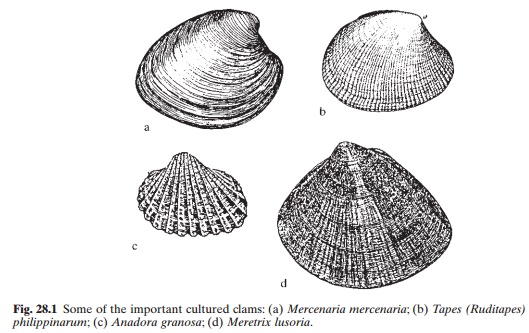Chapter: Aquaculture Principles and Practices: Clams, Scallops and Abalones
Clams

Clams
Clams, or cockles as they are called in some areas, form a valued item
of food in many countries, although they are not so well recognized in others.
The natural resources of clams are believed to be over-exploited in countries
like Italy, where there is greater demand for them as an ingredient in the
normal diet of the population. Simple methods of clam cultivation have been
practised for centuries in China and Japan, and in recent years considerable
research has been carried out, particularly in the USA and the UK, to develop
more sophisticated methods of hatchery production of seed stock and on-growing.
For various reasons, these methods have not yet found wide commercial
application, and most of the present-day clam production is obtained from the
simple systems which have been in existence for a long time, with only marginal
improvements.
From among the many species of clams, belonging to some six families, at
least 18 species have been cultured experimentally or commercially. Of these,
the more important ones in commercial production are: species of Venerupis (= Tapes) in Japan, Korea, the Philippines and the USA; Meretrix in Japan and Taiwan; Mercenaria and Protothaca in the USA and Anadara
in several Southeast Asian countries (fig. 28.1). The species used in
commercial culture are Venerupis japonica
(= Tapessemidecussata, T. japonica)
(Japanese little-neck; Manila clam); Mercenaria
mercenaria(hard clam, quahog); Meretrix
meretrix (big clam); Meretrix lusoria
(clam) and Anadaragranosa (blood cockle).

Most of these species are marine (found in salinities above 20ppt) and
burrow in sand ormud. Though hermaphroditism and protandry have been observed,
the clams are generally dioecious. Fertilization is external and the embryos
pass through the free-swimming trochophore and veliger larval stages before
metamorphosis. They reach sexual maturity within about a year and readily
respond to environmental stimuli, particularly temperature changes, and spawn
easily. Larvae of most clams begin to set within 7–14 days. Though the growth
rate depends very much on food availability and environmental conditions, most
species of clams are reported to grow rapidly for one to four years and
thereafter at a slower rate.
Related Topics